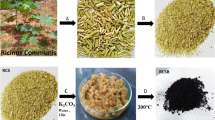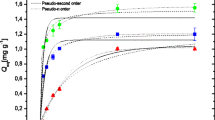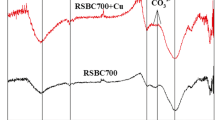Abstract
Potassium carbonate-activated biochar derived from the stems of Ricinus communis (RCSB) and Colocasia esculanta (CESB) was used for the efficient removal of Cd2+ and Pb2+ (50 mg L–1 each) from synthetic wastewater. These two ions’ adsorption is higher than that of other tested heavy metal ions (viz. Ni2+, Zn2+, Cu2+, Hg2+, As5+, and Cr6+ ions). Different adsorption parameters (pH, metal concentration, time, dosage, and temperature) were studied to get the optimized result. The adsorption isotherm, kinetics, thermodynamics, and mechanism were studied. The adsorption isotherm studies indicate that heavy metal ion biosorption follows the Freundlich isotherm. The adsorption kinetic model can be best described as pseudo-second-order, and the adsorption mechanism is physical adsorption. The optimum conditions for the adsorption of Cd2+ and lead Pb2+ by activated biochars were: adsorption time 120 min, temperature 20–25°C, and pH between 6.8 and 7.2. The adsorption capacity of Cd-RCSB, Cd-CESB was ~55 mg g–1, and that of Pb-RCSB, Pb-CESB was found to be ~76 mg g–1. The adsorption thermodynamics showed that the adsorption was a spontaneous and endothermic process. Desorption studies show that biochar can be recycled for up to 5 cycles. All these results can be summed up to show that RCSB and CESB have good potential for removal of heavy metal ions (particularly Cd2+ and Pb2+) from an aqueous environment up to 99%.





Similar content being viewed by others
REFERENCES
Samiee, F., Vahidinia, A., Taravati Javad, M., and Leili, M., Exposure to heavy metals released to the environment through breastfeeding: A probabilistic risk estimation, Sci. Total Environ., 2019, vol. 650, pp. 3075–3083. https://doi.org/10.1016/J.SCITOTENV.2018.10.059
Medhi, H., Chowdhury, P.R., Baruah, P.D., and Bhattacharyya, K.G., Kinetics of aqueous Cu(II) biosorption onto Thevetia peruviana leaf powder, ACS Omega, 2020, vol. 5, pp. 13489–13502. https://doi.org/10.1021/acsomega.9b04032
Suganya, S., Kayalvizhi, K., Kumar, P.S., Saravanan, A., and Kumar, V.V., Biosorption of Pb(II), Ni(II) and Cr(VI) ions from aqueous solution using Rhizoclonium tortuosum: Extended application to nickel plating industrial wastewater, Desalin. Water Treat., 2016, vol. 57, pp. 25114–25139. https://doi.org/10.1080/19443994.2016.1149111
Inyang, H.I., Onwawoma, A., and Bae, S., The Elovich equation as a predictor of lead and cadmium sorption rates on contaminant barrier minerals, Soil Tillage Res., 2016, vol. 155, pp. 124–132. https://doi.org/10.1016/j.still.2015.07.013
Bordoloi, N., Goswami, R., Kumar, M., and Kataki, R., Biosorption of Co(II) from aqueous solution using algal biochar: Kinetics and isotherm studies, Bioresour. Technol., 2017, vol. 244, pp. 1465–1469. https://doi.org/10.1016/j.biortech.2017.05.139
Chen, Z., Zhang, J., Huang, L., Yuan, Z., Li, Z., and Liu, M., Removal of Cd and Pb with biochar made from dairy manure at low temperature, J. Integr. Agric., 2019, vol. 18, pp. 201–210. https://doi.org/10.1016/S2095-3119(18)61987-2
Yahya, M.A., Al-Qodah, Z., and Ngah, C.W.Z., Agricultural bio-waste materials as potential sustainable precursors used for activated carbon production: A review, Renewable Sustainable Energy Rev., 2015, vol. 46, pp. 218–235. https://doi.org/10.1016/j.rser.2015.02.051
Ali, I., Asim, M., and Khan, T.A., Low cost adsorbents for the removal of organic pollutants from wastewater, J. Environ. Manage., 2012, vol. 113, pp. 170–183. https://doi.org/10.1016/j.jenvman.2012.08.028
Jibril, M., Noraini, J., Poh, L.S., and Evuti, A.M., Removal of colour from waste water using coconut shell activated carbon (CSAC) and commercial activated carbon (CAC), J. Teknol. (Sc. Eng.), 2013, vol. 60, pp. 15–19. https://doi.org/10.11113/jt.v60.1435
Garba, A., Basri, H., Nasri, N.S., and Isma’il, R., Synthesis and characterization of porous carbon from biomass using KOH and K2CO3 chemical activation, ARPN J. Eng. Appl. Sci., 2016, vol. 11, pp. 1613–1617.
Martins, A.E., Pereira, M.S., Jorgetto, A.O., Martines, M.A.U., Silva, R.I.V., Saeki, M.J., and Castro, G.R., The reactive surface of Castor leaf [Ricinus communis L.] powder as a green adsorbent for the removal of heavy metals from natural river water, Appl. Surface Sci., 2013, vol. 276, pp. 24–30. https://doi.org/10.1016/j.apsusc.2013.02.096
Banerjee, S., Mukherjee, S., LaminKa-ot, A., Joshi, S.R., Mandal, T., and Halder, G., Biosorptive uptake of Fe2+, Cu2+ and As5+ by activated biochar derived from Colocasia esculenta: Isotherm, kinetics, thermodynamics, and cost estimation, J. Adv. Res., 2016, vol. 7, pp. 597–610. https://doi.org/10.1016/j.jare.2016.06.002
Pathirana, C., Ziyath, A.M., Jinadasa, K.B.S.N., Egodawatta, P., Sarina, S., and Goonetilleke, A., Quantifying the influence of surface physico-chemical properties of biosorbents on heavy metal adsorption, Chemosphere, 2019, vol. 234, pp. 488–495. https://doi.org/10.1016/j.chemosphere.2019.06.074
Repo, E., Warchoł, J.K., Bhatnagar, A., and Sillanpää, M., Heavy metals adsorption by novel EDTA-modified chitosan–silica hybrid materials, J. Colloid Interface Sci., 2011, vol. 358, pp. 261–267.
Escribano, R., Sloan, J.J., Siddique, N., Sze, N., and Dudev, T., Raman spectroscopy of carbon-containing particles, Vibr. Spectrosc., 2001, vol. 26, pp. 179–186. https://doi.org/10.1016/S0924-2031(01)00106-0
Moheb, E.C.E.A.A., Adsorption of cadmium ions from aqueous solutions using sesame as a low-cost biosorbent: Kinetics and equilibrium studies, Int. J. Environ. Sci. Technol., 2015, vol. 12, pp. 2579–2592. https://doi.org/10.1007/s13762-015-0812-3
Shakoor, S. and Nasar, A., Adsorptive decontamination of synthetic wastewater containing crystal violet dye by employing Terminalia arjuna sawdust waste, Groundwater Sustainable Dev., 2018, vol. 7, pp. 30–38.
Tavana, M., Hajipour, V., and Oveisi, S., IoT-based enterprise resource planning: Challenges, open issues, applications, architecture, and future research directions, Internet Things, 2020, vol. 11, p. 100262. https://doi.org/10.1016/j.iot.2020.100262
Tran, T.H., Le, A.H., Pham, T.H., Nguyen, D.T., Chang, S.W., Chung, W.J., and Nguyen, D.D., Adsorption isotherms and kinetic modeling of Methylene Blue dye onto a carbonaceous hydrochar adsorbent derived from coffee husk waste, Sci. Total Environ., 2020, vol. 725, p. 138325. https://doi.org/10.1016/j.scitotenv.2020.138325
Alqadami, A.A., Naushad, M., ALOthman, Z.A., Alsuhybani, M., and Algamdi, M., Excellent adsorptive performance of a new nanocomposite for removal of toxic Pb(II) from aqueous environment: Adsorption mechanism and modeling analysis, J. Hazard. Mater., 2020, vol. 389, p. 121896. https://doi.org/10.1016/J.JHAZMAT.2019.121896
Mallakpour, S. and Motirasoul, F., Cross-linked poly(vinyl alcohol)/modified α-manganese dioxide composite as an innovative adsorbent for lead(II) ions, J. Cleaner Prod., 2019, vol. 224, pp. 592–602.
Kushwaha, A.K., Gupta, N., and Chattopadhyaya, M.C., Adsorption behavior of lead onto a new class of functionalized silica gel, Arab. J. Chem., 2017, vol. 10, pp. S81–S89. https://doi.org/10.1016/J.ARABJC.2012.06.010
Sachan, D., Ghosh, A., and Das, G., Valorization of aquatic weed Salvinia minima to value-added ecofriendly biosorbent: Preferential removal of dye and heavy metal, Int. J. Environ. Sci. Technol., 2023, vol. 20, pp. 3703–3712. https://doi.org/10.1007/s13762-022-04126-7
Meitei, M.D. and Prasad, M.N.V., Lead(II) and cadmium(II) biosorption on Spirodela polyrhiza (L.) Schleiden biomass, J. Environ. Chem. Eng., 2013, vol. 1, pp. 200–207.
Munagapati, V.S., Wen, J.C., Pan, C.L., Gutha, Y., Wen, J.H., and Reddy, G.M., Adsorptive removal of anionic dye (Reactive Black 5) from aqueous solution using chemically modified banana peel powder: Kinetic, isotherm, thermodynamic, and reusability studies, Int. J. Phytorem., 2020, vol. 22, pp. 267–278. https://doi.org/10.1080/15226514.2019.1658709
ACKNOWLEDGMENTS
The authors are thankful to the Center for the Environment and Central Instrument Facility (CIF), IIT Guwahati, for providing necessary instrumental facilities.
Funding
The financial support by DBT (Department of Biotechnology) New Delhi, India, through research grants BT/COE/34/SP28408/2018 is highly acknowledged.
Author information
Authors and Affiliations
Contributions
Partha Protim Bakal: conceptualization, writing (original draft preparation), methodology, formal analysis, and investigation. Gopal Das: conceptualization, writing (review and editing), resources, and supervision.
Corresponding author
Ethics declarations
CONFLICT OF INTEREST
The authors declare that they have no conflicts of interest.
DATA AVAILABILITY
The data supporting this study’s findings are available on request from the corresponding author.
Supplementary Information
About this article
Cite this article
Partha Protim Bakal, Gopal Das Biochar Derived from the Stem of Ricinus communis L. and Colocasia esculanta: Efficient Adsorbent for the Removal of Cd(II) and Pb(II) Ions from an Aqueous Environment. J. Water Chem. Technol. 45, 200–210 (2023). https://doi.org/10.3103/S1063455X23030025
Received:
Revised:
Accepted:
Published:
Issue Date:
DOI: https://doi.org/10.3103/S1063455X23030025




